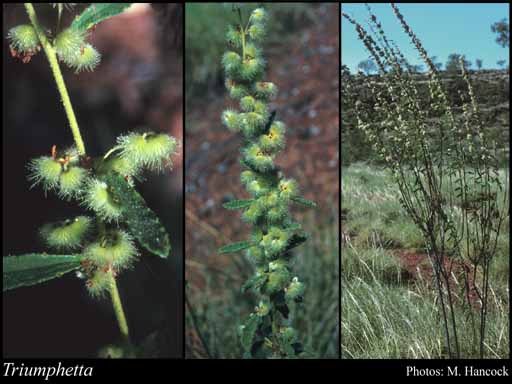- Reference
- Sp.Pl. [Linnaeus] 2:444 (1753)
- Name Status
- Current







Scientific Description
Family Tiliaceae.
Habit and leaf form. Shrubs; leptocaul. Mesophytic. Leaves alternate; spiral; petiolate; non-sheathing; simple. Leaf blades dissected, or entire; conspicuously asymmetric, or not conspicuously asymmetric; when dissected, shallowly or deeply palmately lobed; usually palmately veined. Leaves with stipules. Stipules intrapetiolar; free of one another; caducous. Leaf blade margins crenate, or serrate, or dentate (frequently with glands on basal teeth). Leaves without a persistent basal meristem. Leaf anatomy. Hairs present (hairs usually stellate). Stem anatomy. Nodes tri-lacunar. Secondary thickening developing from a conventional cambial ring.
Reproductive type, pollination. Fertile flowers hermaphrodite (usually), or functionally male and functionally female (in T. deserticola). Unisexual flowers present, or absent. Plants hermaphrodite (usually), or dioecious. Female flowers with staminodes (the stamens with rudimentary anthers). Male flowers with pistillodes (with rudimentary gynoecium).
Inflorescence and flower features. Flowers aggregated in ‘inflorescences’. Inflorescence few-flowered. Flowers in cymes. The terminal inflorescence unit cymose. Inflorescences axillary, or leaf-opposed (or lateral), or terminal (in T. repens); shortly pedunculate, umbel-like, often forming terminal interrupted spicate panicles by reduction of subtending leaves. Flowers bracteate; regular; 5 merous; cyclic, or partially acyclic. Sometimes the androecium acyclic. Floral receptacle developing an androphore (well developed in almost all Australian species, consisting of a short stalk bearing 5 antepetalous glands on its surface and a membranous extrastaminal disc at its apex), or with neither androphore nor gynophore (in T. pentandra). Free hypanthium absent. Hypogynous disk absent. Perianth with distinct calyx and corolla, or sepaline; 5, or 10; 2 -whorled (usually), or 1 -whorled; isomerous. Calyx 5; 1 -whorled; polysepalous; valvate; regular; with a more or less conspicuous, usually apically attached appendage on the abaxial surface; persistent, or not persistent. Epicalyx present, or absent. Corolla 5; 1 -whorled; without prominent gland near base; polypetalous; imbricate; regular; yellow, or yellow to orange. Petals shortly clawed. Corolla members entire. Fertile stamens present, or absent (in female flowers). Androecium (2–)5–30 (or more). Androecial members branched; maturing centrifugally; free of the perianth (inserted on an androphore); free of one another; arranged in one to several whorls. Stamens (2–)5–30 (or more); reduced in number relative to the adjacent perianth to polystemonous. Anthers dorsifixed; dehiscing via longitudinal slits; bilocular; bisporangiate. Fertile gynoecium present, or absent (in male flowers). Gynoecium 2–5 carpelled. The pistil 2–5 celled. Carpels reduced in number relative to the perianth, or isomerous with the perianth. Gynoecium syncarpous; eu-syncarpous; superior. Ovary plurilocular; 2–5 locular. Locules secondarily divided by ‘false septa’ (then appearing 10-locular), or without ‘false septa’. Gynoecium stylate. Styles 1; apical. Stigmas 1; minutely toothed or 2–5-lobed; dry type; papillate; Group II type. Placentation usually axile. Ovules 2 per locule; ascending, or pendulous; apotropous; with ventral raphe, or with lateral raphe; collateral; arillate, or non-arillate; hemianatropous to anatropous.
Fruit and seed features. Fruit non-fleshy; spinose (usually, with prickles or bristles), or not spinose; indehiscent (usually), or dehiscent (in T. pilosa); capsular-indehiscent, or a capsule (rarely). Capsules when dehiscent, loculicidal. Fruit 1–10 seeded. Seeds endospermic. Endosperm oily. Cotyledons 2. Embryo straight, or bent. Micropyle zigzag. Seedling. Germination phanerocotylar.
Physiology, biochemistry. Aluminium accumulation not found. Photosynthetic pathway: C3.
Geography, cytology, number of species. Native of Australia. Not endemic to Australia. Australian states and territories: Western Australia, Northern Territory, and Queensland. Northern Botanical Province and Eremaean Botanical Province.
Taxonomic Literature
- Halford, D. A. 1997. Notes on Tiliaceae in Australia. 3, a revision of the genus Triumfetta L..
- Wheeler, J. R.; Rye, B. L.; Koch, B. L.; Wilson, A. J. G.; Western Australian Herbarium 1992. Flora of the Kimberley region. Western Australian Herbarium.. Como, W.A..